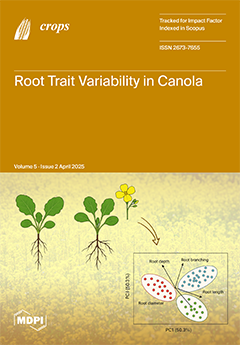Nicosulfuron and topramezone are herbicides with different mechanisms of action, and are recommended for weed control in maize (
Zea mays L.). The objective of this study was to evaluate and compare the effect of both herbicides, at increasing doses of 0, 1×
[...] Read more.
Nicosulfuron and topramezone are herbicides with different mechanisms of action, and are recommended for weed control in maize (
Zea mays L.). The objective of this study was to evaluate and compare the effect of both herbicides, at increasing doses of 0, 1× and 3×, equivalent to 0, 60, and 180 g ai ha
−1 for nicosulfuron, and 0, 33.6, and 100.8 g ai ha
−1 for topramezone, on physiological and agronomic characteristics in 29 maize lines, including S
2, S
3 and S
4, using an alpha-lattice incomplete block design. The cluster analysis divided our genotypes into two groups for both herbicides, based on their higher or lower fresh weight. The results showed a reduction in the SPAD index for both herbicides at 7 days after application, and nicosulfuron caused a reduction in the green matter weight of 33.4%. Similarly, nicosulfuron caused a delay and a reduction in its doses, after an initial increase, for all the agronomic variables, female flowering (FF), male flowering (MF), plant height (PH), ear height (EH), and grain weight (GW), in doses of 60 and 180 g ai ha
−1, while topramezone only affected PH (1×–3×) and EH (3×). When comparing the applications of both herbicides on the maize genotypes, a difference in female and male flowering of 5.09 and 4.86 days, respectively was observed. A differential response and greater damage to nicosulfuron were observed in maize genotypes, with respect to topramezone applications.
Full article





